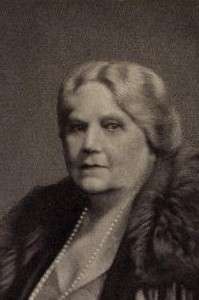Minerva Hamilton Hoyt

Minerva Hamilton Hoyt (1866-1945) was an early American activist who worked to preserve California desert areas, including Joshua Tree National Park.[1] Born on a Holmes County, Mississippi, plantation, she moved as a young woman with her husband to Pasadena, California. Her interest in gardens led her to learn more about desert plants and work for their preservation.
Early life and move to California
Minerva Hamilton was born on March 27, 1866 on a plantation near Durant, Mississippi to an upper-class family. She attended a local school.
After marrying Albert Hoyt, she moved with him to Pasadena, California. In Pasadena, Hoyt was a wealthy socialite and civic activist, working for a variety of civic causes, such as the Los Angeles Symphony.[2]
Involvement in natural preservation
Hoyt became interested in Southern California's desert plants through her interest in gardening, particularly cactus and Joshua Trees. After the death of her husband in 1918,[2] she became concerned that increased automobile traffic in the desert was threatening the area.[1]
She began to exhibit desert plants across the country, to educate people about their qualities, starting at the 1928 Garden Club of America show in New York. She later exhibited as far as London. In 1930, Hoyt founded the International Desert Conservation League. Throughout the 1930s she worked to encourage the state of California to create three parks, including Joshua Tree, Death Valley, and Anza-Borrego Desert. She also persuaded the Mexican government to set aside 10,000 acres for cactus preservation.[3] In 1936, her efforts persuaded the administration of President Roosevelt to designate more than 800,000 acres in the area as the Joshua Tree National Monument.[4]
Legacy and honors
- In 1931, a species of Mexican cactus was named after Hoyt (mammillaria hamiltonhoytea).[5]
- In 2013, the US Board of Geographic Names named a peak within Joshua Tree after Minerva Hoyt.[6]
- The Joshua Tree National Park Association annually honors "notable achievement on behalf of the deserts of California" with a Minerva Hoyt Award.[7]
References
- 1 2 Gloria G. Harris, Hannah S. Cohen. Women Trailblazers of California: Pioneers to the Present. pp. 80–83. ISBN 1609496752. Retrieved 17 December 2013.
- 1 2 American Biography: A New Cyclopedia. New York: American Historical Society. pp. 3–6.
- ↑ Kaufman, Polly Welts (2006). National Parks and the Woman's Voice: A History. UNM Press. pp. 36–39. ISBN 9780826339942.
- ↑ Zarki, Joe. "A Park for Minerva". National Park Service. Retrieved 17 December 2013.
- ↑ Sorensen, Connor (1976). ""Apostle of the Cacti": The Society Matron as Environmental Activist". Southern California Quarterly (Fall): 407–429. doi:10.2307/41170663.
- ↑ Zarki, Joe. "Joshua Tree Peak named for park founder". Retrieved 17 December 2013.
- ↑ "Minerva Hoyt Award". Retrieved 28 June 2014.